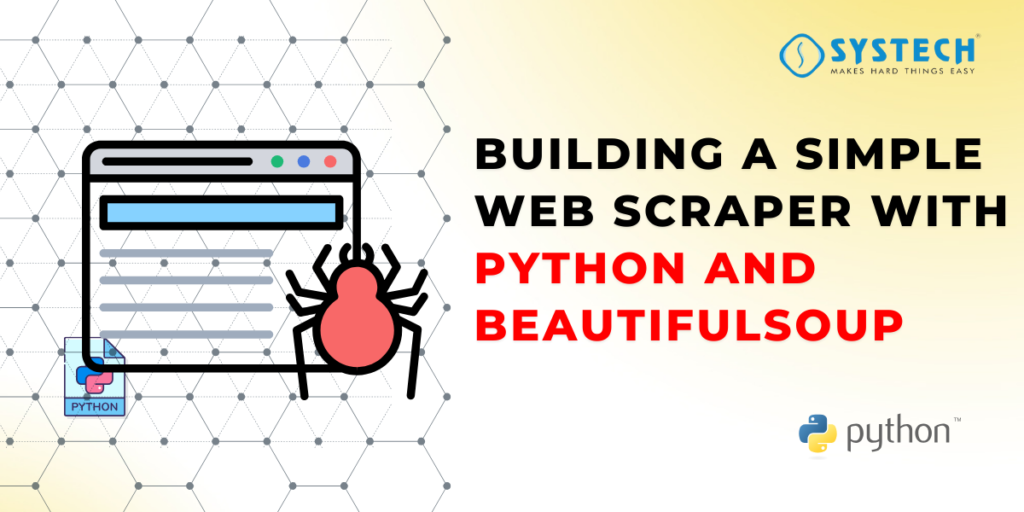Table of Contents
Web Scraping Using Python BeautifulSoup: A Complete Guide
Web scraping is an essential skill for anyone involved in data science, automation, or simply gathering information from the web. Whether you need to monitor competitor pricing, collect research data, or automate the extraction of information from multiple web pages, web scraping using Python BeautifulSoup provides a simple and efficient solution. In this guide, we will delve into the core concepts of BeautifulSoup web scraping, break down each step of the process, and provide practical examples to help you get started.
What is Web Scraping and Why Use Python with BeautifulSoup?
Web scraping refers to the process of extracting data from websites by parsing the HTML or XML code of a page. This allows users to gather structured data from the web, which can be used for a variety of purposes such as market research, data analysis, or even building automated bots.
Python has become one of the most popular languages for web scraping, thanks to its simplicity and a wide range of libraries designed for this task. One of the most powerful and easy-to-use libraries for web scraping with BeautifulSoup is BeautifulSoup, which enables you to parse HTML documents and extract the data you need with minimal effort.
Why BeautifulSoup for Web Scraping?
- Ease of Use: BeautifulSoup is beginner-friendly. It has a simple syntax and an intuitive API, making it accessible even for those who have little experience with Python.
- Flexibility: BeautifulSoup can parse messy HTML and even handle malformed tags and broken documents. This makes it especially useful for real-world scraping, where websites often do not adhere to perfect HTML standards.
- Integration: BeautifulSoup works well with other Python libraries, such as Requests for sending HTTP requests and Pandas for storing and manipulating data.
Getting Started with Web Scraping Using Python BeautifulSoup
To start scraping websites using Python BeautifulSoup, you need to install the necessary libraries and learn the basic steps involved. Here’s a step-by-step guide to get you started.
Step 1: Installing Required Libraries
Before you can scrape a webpage, you need to install the required libraries. Two primary libraries are used in this process:
- Requests – For sending HTTP requests to retrieve web pages.
- BeautifulSoup4 – For parsing the HTML content of a webpage.
Install these libraries via pip by running the following command:
pip install requests beautifulsoup4
These libraries are lightweight and work seamlessly together to simplify the scraping process.
Step 2: Sending an HTTP Request to Retrieve HTML Content
Once the libraries are installed, the next step is to retrieve the HTML content of the webpage you wish to scrape. This can be done by sending an HTTP request using the requests library.
Here’s a basic example of how to send an HTTP GET request to retrieve a webpage:
import requests
url = "https://example.com" # Replace with the URL of the webpage you want to scrape
response = requests.get(url)
# Check if the request was successful
if response.status_code == 200:
print("Page accessed successfully!")
html_content = response.text
else:
print("Failed to retrieve the page.")
In this example, we use requests.get() to retrieve the HTML of the page. The response.text contains the raw HTML, which will then be passed to BeautifulSoup for parsing.
Step 3: Parsing the HTML Content with BeautifulSoup
BeautifulSoup allows you to parse the raw HTML into a structured format. You can now use BeautifulSoup to extract specific elements from the webpage.
from bs4 import BeautifulSoup
# Parse the HTML content using BeautifulSoup
soup = BeautifulSoup(html_content, 'html.parser')
# Pretty-print the parsed HTML
print(soup.prettify())
The prettify() function formats the HTML, making it easier to read and navigate. This is useful when you’re trying to understand the structure of the document and identify the tags or elements you want to scrape.
Step 4: Navigating and Extracting Data
Now that the HTML content is parsed, you can navigate the document tree to extract specific pieces of data. BeautifulSoup provides several methods to search for elements, such as:
.find()– Finds the first occurrence of a tag..find_all()– Finds all occurrences of a tag..get_text()– Extracts the text inside a tag..get()– Extracts the value of an attribute.
For example, if you wanted to extract all links (<a> tags) from the page, you could use the following code:
# Find all the links on the page
links = soup.find_all('a')
for link in links:
print(link.get('href'))
This will print out all the hyperlinks found on the webpage. You can modify the code to target specific elements, such as product names or prices, by using the appropriate HTML tag and class.
Practical Example: Scraping Product Information
To further illustrate web scraping using Python BeautifulSoup, let’s implement a simple example of scraping product names and prices from an e-commerce website.
import requests
from bs4 import BeautifulSoup
url = 'https://example.com/products' # Replace with an actual product page URL
response = requests.get(url)
if response.status_code == 200:
soup = BeautifulSoup(response.text, 'html.parser')
# Find all product listings
products = soup.find_all('div', class_='product')
for product in products:
# Extract product name
name = product.find('h2', class_='product-name').text.strip()
# Extract product price
price = product.find('span', class_='product-price').text.strip()
print(f"Product Name: {name}, Price: {price}")
In this example:
- We send a GET request to the products page.
- Use BeautifulSoup to parse the HTML content.
- Find all div elements with the class product (which represents each product).
- Extract the name of the product from the h2 tag and the price from the span tag.
Output Example:
Product Name: Wireless Headphones, Price: $49.99
Product Name: Bluetooth Speaker, Price: $29.99
Advanced Web Scraping Techniques
As you become more comfortable with scraping websites using Python, you may encounter websites with dynamic content, pagination, or forms that require authentication. Here are some advanced techniques to handle these challenges:
1. Handling Pagination
Many websites paginate their content, displaying products or articles across multiple pages. To scrape all the content, you need to automate the process of navigating through each page. This can be done by modifying the URL to point to the next page or extracting links to subsequent pages from the current page.
2. Scraping JavaScript-Rendered Content
Some websites use JavaScript to load data dynamically. BeautifulSoup can only parse static HTML, so in these cases, you may need to use a tool like Selenium to simulate a web browser and extract the dynamically-loaded content.
3. Handling Forms and Authentication
For websites that require login or form submission, you can simulate form interactions with Python libraries like Requests or Selenium. This allows you to submit login credentials or search queries automatically and scrape data from authenticated pages.
Best Practices for Web Scraping
While web scraping using Python BeautifulSoup is powerful, it’s essential to adhere to ethical guidelines and best practices:
- Check the website’s robots.txt file: This file specifies which pages can and cannot be scraped. Always respect a website’s scraping rules.
- Limit the frequency of requests: To avoid overloading the website’s server, make sure to space out your requests by adding delays between them.
- Handle errors gracefully: Websites can change their structure, causing your scraping code to break. Always implement error handling to deal with missing data or unexpected changes in the HTML structure.
- Use proxies and user agents: If you’re scraping large amounts of data, rotating IP addresses (via proxies) and using different user agents can help avoid detection and blocking.
Conclusion
In this comprehensive guide, we’ve covered everything you need to know about web scraping using Python BeautifulSoup. From understanding the basics to handling advanced techniques, this tutorial has provided the foundational knowledge to scrape websites and extract useful data with ease.
By following the steps outlined, you can begin building your own web scraping projects using Python, whether it’s for data analysis, market research, or automating repetitive tasks. Remember to always respect the websites you’re scraping and avoid putting undue strain on their servers.
As you grow more familiar with BeautifulSoup web scraping, you can expand your skills to handle more complex scenarios, like dynamic websites or scraping multiple pages. Happy scraping!
Learn web scraping with Python BeautifulSoup now!
Start LearningFAQs
Is web scraping legal?
Web scraping legality depends on the website and its terms of service. Always check the site’s robots.txt file to understand its scraping policies and avoid scraping data that violates copyright or privacy laws. Ensure you have permission if scraping sensitive or proprietary information.
How do I scrape data from websites with dynamic content?
BeautifulSoup only works with static HTML. For dynamic content rendered by JavaScript, you can use tools like Selenium or Playwright, which simulate a browser and allow you to interact with JavaScript-rendered elements. Alternatively, check if the website provides an API for data access.
How can I avoid being blocked while scraping?
To minimize the chances of being blocked:
- Use rotating IPs or proxies.
- Implement random delays between requests.
- Rotate user-agent headers to mimic real browsers.
- Limit the frequency of requests to avoid overwhelming the server.
How do I store the scraped data for later use?
- CSV: Use Python’s
csvmodule or Pandas to save data in spreadsheet format. - JSON: Use Python’s
jsonmodule for structured data. - Database: Use libraries like
sqlite3for local databases orSQLAlchemyfor larger-scale database management. - Excel: Use the
openpyxlorpandaslibrary for exporting to Excel files

